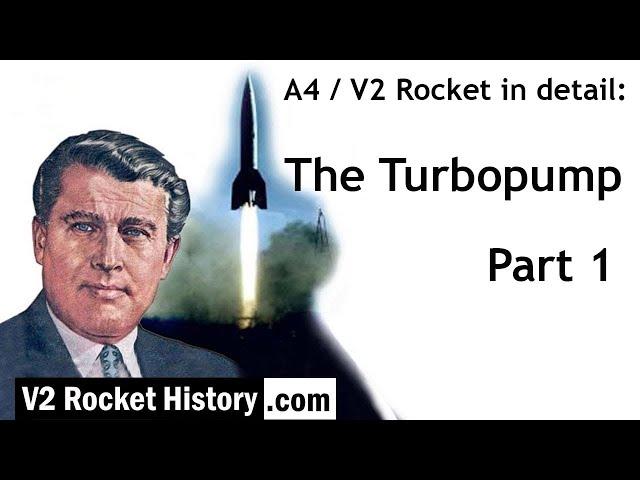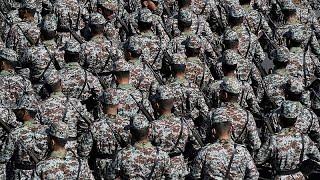
A4 / V2 Rocket in detail: Turbopump
Комментарии:

he is was and will always be a Murder
Ответить
Вытеснительная система была на ракетах SS-1c Scud B .
Перманганат не деградировал т.к. разложился до оксида марганца который тоже не хуже канализатор.

fascinating.
Thanks form france !

One would think rhe LOX pressure would be all that is needed....wrong !!
Ответить
36 years and you finally managed to make a stator click for me
Ответить
The impeller is mounted in the reverse position if the rotation of the video is correct
Ответить
Can we print some of the 3d printed models that were shown in this video? I looked at the companion website and I found lots of nice images of 3d models, but no stl model downloads?
Ответить
It is hard to believe that it was made by slave labor! It is such advanced technology, especially for the time.
Ответить
Why does it look like the vanes in the alcohol impeller is slanted to the wrong side at the 20min mark? The way it's slanted and the direction of rotation shown would not work.
Ответить
They weren't that stupid back then either, the turbo pump ensured a constant pressure/flow. If you pressurize the fuel tank with pressure tanks, you don't get a constant pressure. The emptier the tank, the lower the pressure becomes because the gas filled in is increasingly difficult to compress.
There are other factors too, for example: a data center once used a high-pressure CO2 injection system to put out fires. A test run was carried out after it had been freshly installed. The shock-like increase in pressure in the room killed most of the hard drives running there. They suffered a head crash because the hard drive header floats on a defined air cushion, which is determined by the rotation of the disks.

Did someone install the alcohol impeller backwards on the museum model? It doesn’t look like its rotation matches the turbine bucket direction.
Ответить
If you are not a teacher you should be
Ответить
While this is an a excellent video I'd like to point out that the Turbo Pump in the musemum would not work in real life. The fuel impeller is installed backwards, the convolutes on both pumps MUST be in the same direction. The steam nozzles indicate the correct direction of rotation and the Oxygen impeller flutes are correct to create pressure, the fuel must turn in the same direction and its flutes are the reverse of the Oxygen. The Russan Turbo pump shows it correctly. :) Old USN pump guy! Otherwise a great video, grew up around someone who later became the youngest Flight Director for several years for the Air Force. I learned a few things from him over the years.
Ответить
Now I really want to know what kind of torque that steam rotor can generate.
Ответить
Despite extensive discussion, I could not get the pressures -steam pressure and pump outlet pressures.
Ответить
Fabulous. thanks!
Ответить
Well-Done
Ответить
Amazing video. Thank you for all of your time and hard work
Ответить
This is beyond awesome!! This channel’s playlist associated with the V-2 is an incredible treasure trove of information!!
Ответить
Thank you, a fascinating subject superbly explained.
Ответить
the tune!
Ответить
Amazingly thorough and well presented. Simplified rocket science!
Ответить
Thank goodness for 3D printing!
Ответить
Feeding the 8 ton output through the 25 ton valve also helps open the valve on the 25 ton unit, so that less air pressure is required.
Ответить
Excellent video. Loved it. Thank you.
Ответить
This is amazing! Thank you!
Ответить
I have enjoyed this video. I stumbled upon this video by trying to find where my uncle served. He was a MP in the US Army and guarded captured V2 rockets. He would speak about the rockets and then the work camps and he would not talk about them. Being a mechanic on class 8 trucks and dealing with petroleum he caught my interest.
Ответить
Turbopump is now using in the improving type.
Ответить
I was intrigued to hear of "the peroxide valve moving off its rubber seat" during discussion of the 25-tonne valve and how it operates. I would have thought that putting rubber in contact with 80% HTP would result in a vigorous fire... perhaps some special oxidation-resistant synthetic rubber was used?
Ответить
I guess there's something hie.., what it's called an 💍?
Ответить
I built one for my 69 stang
Ответить
My takeaway messages are: 1. There is reason that German make that mess at the time. 2. That turbo pump system can be easily replaced by a blushless motor system and make a V3
Ответить
43.59 "sodium permanganate"?
Ответить
Google condenser traps. Float switch to bleed the water out of the sump
Ответить
I read that the steam generator could produced 750 psi of steam pressure. A lot of work can be done that.
Ответить
Turbonique engine
Ответить
Where does the steam come from?
Ответить
I’m weird. I’m interested in how they made the cutaway sections ? Is it sawed or torched then filed or water jet cutter ? I mean it’s a complicated shape to perform on no matter which process is used.
Ответить
The new SpaceX Raptor 2 engines' turbopumps are 75,000 shaft horsepower and has an outlet pressure of 750 bar. We've come a long way. :)
Ответить
Got a free pass from the hang man.!!
Ответить
Would love to see some .STL files for the model of the turbo pump! Even model mashing its very hard to make turbopump scale models. I am working on an H.O. scale briteline idea w a model of cape Kennedy at the north and and meet up w the FEC at a model of the Palm Beach Island Flagler House.
Ответить
Great job! Thanks for the education! What a complicated system!
Ответить
Truly incredible details and great explanations. Your boneyard is outstanding! I would like to see a video on what the technicians had to go through to setup, test, fuel and launch an A4 rocket. Have you seen or run across that type of information?
Ответить
Those F-1s might have been simple in design, but very complex in execution
Ответить
really interesting
Ответить

























